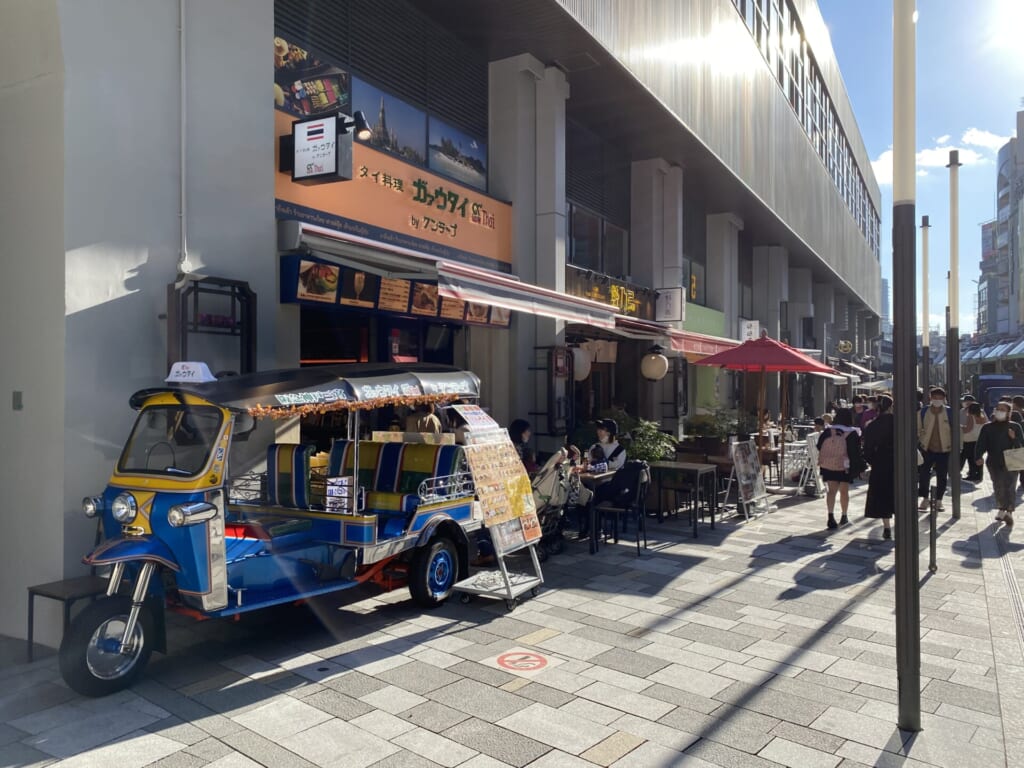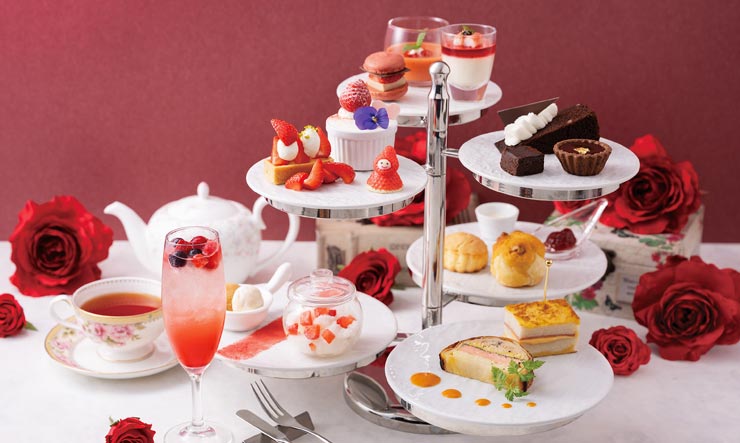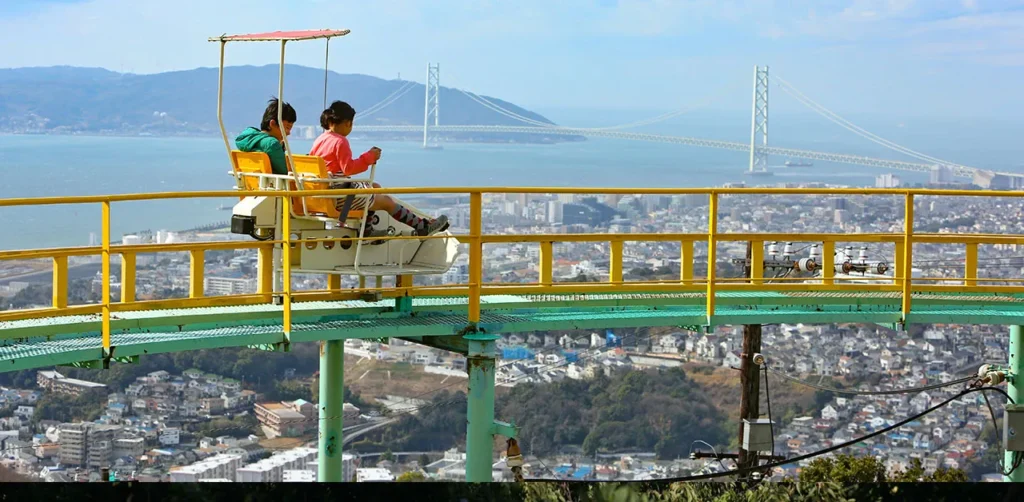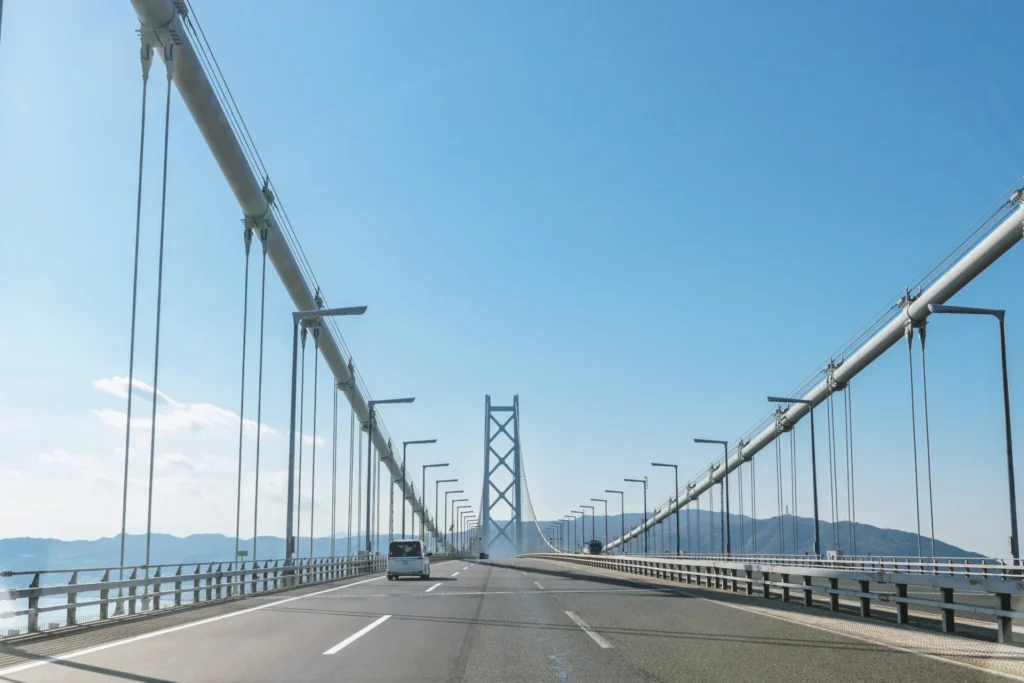โกเบ
โกเบมีความเพลิดเพลินหลากหลายแง่มุมที่รอให้คุณไปสัมผัส รวมถึงบริเวณท่าเรือที่สวยงาม ภูเขาที่มองเห็นวิวทิวทัศน์ในยามค่ำคืน ถนนที่เต็มไปด้วยวัฒนธรรมผสมที่แปลกใหม่ และรีสอร์ทน้ำพุร้อนที่แบ่งเป็นชั้น ๆ
-

Nada Gogo
-

EKIZO KOBE SANNOMIYA
-

โกเบ คิตาโนะ อิจินคัง
-

Amagasaki Ebisu Shine
-

Mount Rokko Adventure Kingdom GREENIA
-

Kobe Animal Kingdom
-

Rokko-Shidare Observatory
-

พิพิธภัณฑ์สาเกซาวาโนะซึรุ
-

Amagasaki Castle
-

Kobe Steak Roasted Beef Studio WAKKOQU
-

Meriken Park
-

สวนสมุนไพรและกระเช้าลอยฟ้านูโนบิกิแห่งเมืองโกเบ
บทความที่เกี่ยวข้อง
-

ฮิตมากในญี่ปุ่น! 4 ไอเดียชายามบ่ายรสสตรอว์เบอร์รีรอบโอซาก้า
“ชายามบ่าย” กำลังเป็นที่นิยมในญี่ปุ่น! ชายามบ่ายมีต้นกำเนิดมาจากประเทศอังกฤษ แต่ปัจจุบันชายามบ่ายของญี่ปุ่นกำลังได้รับความนิยมมากขึ้นด้วยรูปลักษณ์ที่สวยงาม ทุกๆ ปี ตั้งแต่เดือนธันวาคมถึงฤดูใบไม้ผลิ ชายามบ่ายธีม “สตรอว์เบอร์รี” จะปรากฏในโรงแรมและคาเฟ่ต่างๆ สตรอว์เบอร์รีสีแดงสดสะดุดตาเป็นหนึ่งในชายามบ่ายที่ได้รับความนิยมมากที่สุดของปี บทความนี้จึงขอแนะนำชายามบ่ายสตรอว์เบอร์รีที่เสิร์ฟตามโรงแรมในโอซาก้าและเฮียวโกะ เพื่อให้คุณได้สัมผัสประสบการณ์สุดพิเศษ *ภาพทั้งหมดเป็นภาพถ่าย -INDEX- 1.【Osaka Umeda】Hotel Hankyu International “ชุดน้ำชายามบ่าย -Supreme-“ 2.【Osaka Fukushima】Hotel Hanshin Osaka “ชุดน้ำชายามบ่าย -very berry night-” 3.【Hyogo Takarazuka】Takarazuka Hotel “ชุดน้ำชายามบ่ายฤดูหนาว -berry×chocolate -” 4.【Osaka Fukushima】Hotel Hanshin Osaka “ชุดน้ำชายามบ่ายญี่ปุ่นฤดูหนาว -Nagomi-” ระยะเวลา: 1 ธันวาคม 2025 – 28 กุมภาพันธ์ 2026 ※จำนวนจำกัด เริ่มต้นประสบการณ์ของคุณด้วยเครื่องดื่มต้อนรับที่ชุดน้ำชายามบ่ายธีมสตรอว์เบอร์รีของ Hotel Hankyu International ฤดูหนาวนี้ ชุดน้ำชามีสองรสชาติที่น่าดึงดูดใจ ได้แก่ สตรอว์เบอร์รีหวานและช็อกโกแลตเข้มข้น แม้แต่อาหารคาวก็ใช้สตรอว์เบอร์รี ไฮไลท์ ได้แก่ ซุปสตรอว์เบอร์รีและมะเขือเทศพร้อมกระวานและมาการอง Framboise พร้อมสตรอว์เบอร์รีและมูสฟัวกราส์ นำเสนออย่างสวยงามทั้งห้าเมนูนี้ ชวนให้ลิ้มลองและเพลิดเพลิน ส่วนของหวาน ลิ้มลองขนมหวานรสสตรอว์เบอร์รีสามอย่าง ได้แก่ สตรอว์เบอร์รีชอร์ตเค้ก มินิสตรอว์เบอร์รีทาร์ต และสตรอว์เบอร์รีแฟรี่ช็อกโกแลต เสิร์ฟพร้อมช็อกโกแลตเข้มข้นสามอย่าง ได้แก่ เค้กช็อกโกแลตคลาสสิก กาโตช็อกโกแลต และทาร์ตช็อกโกแลต นอกจากนี้ยังมีสโคน คุกกี้สโนว์บอล และอื่นๆ รวมเป็น 11 เมนูสุดอร่อย เสิร์ฟพร้อมขนมเปอตีฟูร์และเครื่องดื่มไม่อั้นอย่าง “JING TEA” แบรนด์ชาที่ก่อตั้งขึ้นในปี 2004 ช่วงเวลา: 1 ธันวาคม 2025 – 28 กุมภาพันธ์ 2026 ปิด: วันอาทิตย์ วันจันทร์ และวันหยุดนักขัตฤกษ์ ชายามบ่ายธีมสตรอว์เบอร์รีและเบอร์รีที่เสิร์ฟที่ Caballero บาร์บนชั้น 7 เหมาะสำหรับผู้ที่ต้องการเพลิดเพลินกับขนมหวานพร้อมเครื่องดื่ม ชุดน้ำชายามบ่ายยามค่ำคืนมีให้บริการเฉพาะหลัง 17.00 น. ประกอบด้วยขนมหวาน 8 รายการ อาหารคาว 5 รายการ และแชมเปญ 1 แก้วหรือ "Strawberry Tonic" ที่ไม่มีแอลกอฮอล์ให้เลือก อาหารคาวทั้งหมดมีสตรอว์เบอร์รีเป็นส่วนประกอบ ทำให้เข้ากันได้ดีกับทั้งแชมเปญและค็อกเทลที่ไม่มีแอลกอฮอล์ คุณยังสามารถสั่งเครื่องดื่มแอลกอฮอล์ได้ไม่อั้นโดยมีค่าใช้จ่ายเพิ่มเติม เพลิดเพลินกับช่วงเวลาที่ผ่อนคลายและหรูหราในฐานะผู้ใหญ่ในพื้นที่ที่เหมือนบ้านส่วนตัวแห่งนี้ ช่วงเวลา: 1 ธันวาคม 2025 - 28 กุมภาพันธ์ 2026 Takarazuka Hotel ตั้งอยู่ติดกับ Takarazuka Grand Theater พื้นที่ที่หรูหราและคลาสสิกทำให้คุณรู้สึกราวกับว่าคุณคือฮีโร่ของเรื่องราว ชายามบ่ายสุดหรูมีให้บริการที่เลานจ์บนชั้น 1 ขนมหวานประกอบด้วยผลงานสร้างสรรค์ที่สะดุดตา เช่น มูสเบอร์รี่ราดด้วยมงกุฎช็อกโกแลต และเยลลี่ส้มและองุ่นเสิร์ฟพร้อมคุกกี้รูปหน้ากาก ซึ่งเป็นขนมที่สมบูรณ์แบบสำหรับรับประทานก่อนหรือหลังการแสดง Takarazuka แม้ว่าสินค้าแต่ละชิ้นจะดูโดดเด่น แต่การออกแบบโดยรวมยังคงมีความซับซ้อนและประณีต ตั้งแต่กาน้ำชาที่ออกแบบอย่างประณีตไปจนถึงถ้วยและจานรองที่เข้าชุดกัน ช้อนส้อม และการบริการของพนักงานที่เอาใจใส่ พื้นที่ที่สะดวกสบายได้รับการสร้างขึ้นเพื่อช่วงเวลาจิบชาอันแสนวิเศษ ช่วงเวลา: เฉพาะวันธรรมดา ตั้งแต่วันที่ 4 พฤศจิกายน 2568 ถึง 27 กุมภาพันธ์ 2569 ปิด: 24-25 ธันวาคม 2568 และ 1-4 มกราคม 2569 ในที่สุด แม้ว่าจะไม่ใช่ชายามบ่ายรสสตรอว์เบอร์รี แต่เราอยากแนะนำให้คุณรู้จักกับชายามบ่ายที่ไม่เหมือนใครที่จะทำให้การเดินทางในญี่ปุ่นของคุณน่าจดจำ! ร้านอาหารญี่ปุ่น Hanaza ตั้งอยู่บนชั้นสองของ Hotel Hanshin Osaka ให้บริการชายามบ่ายสไตล์ญี่ปุ่นเฉพาะวันธรรมดา สิ่งแรกที่ดึงดูดสายตาของคุณคือกล่องนำเสนอสามชั้นอันหรูหรา ภายในคุณจะพบกับขนมหวานที่รังสรรค์อย่างสวยงาม เช่น ถั่วพีชบดกับกลิ่นโฮจิฉะเสียบไม้และมัทฉะเทอร์รีนช็อกโกแลต พร้อมกับสโคนธรรมดาและสโคนมันหวานเสิร์ฟพร้อมครีมคลอตเต็ดและขนมกรุบกรอบ เมนูอาหารคาวมีให้เลือกหลากหลาย อาทิ ฟัวกราส์ชาวันมูชิ และเนื้ออบ รสชาติกลมกล่อมลงตัว จิบชายามบ่ายสไตล์ญี่ปุ่นที่หาทานได้ยากและปริมาณเยอะ ดื่มด่ำกับชาญี่ปุ่นหลากหลายชนิดที่มีให้เลือกสรรอย่างอิสระ จิบชายามบ่ายสไตล์ญี่ปุ่นที่ยังคงได้รับความนิยมอย่างต่อเนื่อง ยังคงเป็นเมนูยอดนิยมสำหรับคนรักขนมหวาน! สัมผัสเทรนด์ใหม่ แล้วมาเพลิดเพลินกับทริปญี่ปุ่นที่แตกต่างจากที่อื่น
-

สวนสนุกโกเบ・สุมาอุระซันโจ|เครื่องเล่นย้อนยุค ชมวิวทะเลเซโตะอันน่าทึ่ง และดอกซากุระอันตระการตา
คุณเคยได้ยินชื่อสวนสนุกสุมะอุระ ซันโจ ในโกเบไหม สถานที่ย้อนยุคที่ได้รับความนิยมทั้งบนโซเชียลมีเดียและสื่อต่างๆ? ถึงแม้ที่นี่อาจจะไม่ได้มีเทคโนโลยีล้ำสมัยหรือเครื่องเล่นไฮเทคอะไรมากมายนัก แต่ที่นี่ก็เต็มไปด้วยเครื่องเล่นสุดหรรษา เครื่องเล่นสุดตื่นเต้น และทิวทัศน์อันน่าทึ่งที่หาไม่ได้จากที่อื่น สวนสนุกสุมะอุระ ซันโจ คือสถานที่ที่คุณจะได้เพลิดเพลินกับช่วงเวลาอันแสนอบอุ่นราวกับได้ย้อนเวลากลับไปในยุคโชวะ <ดัชนี> 1. สวนสนุกสุมะอุระ ซันโจ คืออะไร? 2. ทางเข้าสวนสนุกสุมะอุระ ซันโจ 3. ตั๋วส่วนลดสวนสนุกสุมะอุระ ซันโจ 4. สามเหตุผลที่ควรไปสวนสนุกสุมะอุระ ซันโจ ・เครื่องเล่นสุดพิเศษที่สวนสนุกสุมะอุระ ซันโจ ・รถไฟรางเดี่ยวลอยฟ้า ・คาเฟ่หมุน “Kissa Cosmos” พร้อมวิวพาโนรามา 5. วิวจากจุดชมวิวของสวนสนุกสุมะอุระ ซันโจ 6. สถานที่แนะนำรอบๆ สวนสนุกสุมะอุระ ซันโจ ・Kobe Suma Sea World ・Kobe Suma Rikyu Park สวนสนุกสุมะอุระ ซันโจ เปิดให้บริการในปี พ.ศ. 2502 เป็นสวนสนุกสไตล์ย้อนยุคที่มีเสน่ห์ตั้งอยู่บนยอดเขา นักท่องเที่ยวสามารถนั่งกระเช้าลอยฟ้า บันไดเลื่อน “Car-later” อันเป็นเอกลักษณ์ และลิฟต์ชมวิวเพื่อขึ้นไปยังยอดเขา เมื่อถึงที่นั่น คุณจะพบกับความสนุกสนานแบบย้อนยุคมากมาย รวมถึงรถไฟรางเดี่ยว มินิคาร์แลนด์ และสนามเด็กเล่น นอกจากนี้ยังมีลานบาร์บีคิวและหอสังเกตการณ์หมุนที่หายาก ซึ่งมีกิจกรรมสนุกๆ มากมาย จากสวนสาธารณะ คุณสามารถชื่นชมทะเลเซโตะอันเงียบสงบ รวมถึงวิวทิวทัศน์อันงดงามของสะพานอาคาชิไคเคียวและเกาะ Awaji สามารถเดินทางไปยังสวนสนุกสุมะอุระซันโจได้โดยรถไฟ 〇จากโอซาก้า / Kobe-Sannomiya จากสถานี Hanshin Osaka-Umeda รถไฟฮันชิน ขึ้นรถไฟด่วนพิเศษ (Limited Express) มุ่งหน้าสู่ Sanyo-Suma เมจิ ไปยังสถานีซันโย-สุมะ จากนั้นเปลี่ยนไปขึ้นรถไฟธรรมดาและลงที่สถานีสุมะอุระ-โคเอ็น ทางเข้าสวนสนุกอยู่ด้านนอกสถานี 〇จากอาคาชิ / ฮิเมจิ จากสถานีซันโย รถไฟซันโย ขึ้นรถไฟด่วนพิเศษ (Limited Express) มุ่งหน้าสู่ฮั Hanshin Sanyo-Tarumi มิ จากนั้นเปลี่ยนไปขึ้นรถไฟธรรมดาและลงที่สถานีสุมะอุระ-โคเอ็น ทางเข้าสวนสนุกอยู่ด้านนอกสถานี จากสถานี Sumaura-Koen คุณจะต้องนั่งรถไฟหลายสายไปยังสวนสนุก Sumaura Sanjo บนยอดเขา: กระเช้าลอยฟ้า (ประมาณ 3 นาที) → ขึ้นรถทีหลัง (ประมาณ 2 นาที 20 วินาที) → ลิฟต์ชมวิว (ประมาณ 4 นาที 15 วินาที) เราขอแนะนำให้ใช้ตั๋ว Hanshin & Sanyo Seaside 1-Day Ticket เมื่อมาเยี่ยมชมสวนสนุก Sumaura Sanjo ตั๋วนี้สะดวกและประหยัด ให้คุณเดินทางได้ไม่จำกัดจำนวนเที่ยวในหนึ่งวัน ระหว่างสถานี Osaka-Umeda / สถานี Osaka-Namba ของรถไฟ Hanshin และสถานี Sanyo-Himeji ของรถไฟ Sanyo เราขอแนะนำให้คุณซื้อ “ตั๋วเที่ยวกลับสวนสนุก Sumaura Sanjo แบบลดราคา – คอร์ส A” ที่สวนสนุกด้วย ตั๋วไปกลับนี้รวมค่ากระเช้าลอยฟ้า ขึ้นรถทีหลัง ลิฟต์ชมวิว และค่าเข้าชมหอสังเกตการณ์・ผู้ใหญ่ (นักเรียนมัธยมต้นขึ้นไป): 2,100 เยน ・เด็ก (นักเรียนประถม): 1,600 เยน * เด็กก่อนวัยเรียนเข้าชมฟรี ขอแนะนำ 3 ไฮไลท์ห้ามพลาดเมื่อมาเยือนสวนสนุกสุมะอุระซันโจ การเดินทางไปยังสวนสนุกสุมะอุระซันโจ จะต้องเปลี่ยนเครื่องเล่นที่น่าตื่นเต้น 3 ชนิด จากกระเช้าลอยฟ้าสายแรก การเดินทางทั้งหมดใช้เวลาอย่างน้อย 60 นาที โดยทั่วไปประมาณ 90 นาที หรือสูงสุด 120 นาที หากคุณต้องการใช้เวลาอย่างเต็มที่และเพลิดเพลินไปกับประสบการณ์ การเดินทางของคุณจะเริ่มต้นด้วยกระเช้าลอยฟ้าที่เชื่อมต่อโดยตรงกับสถานีรถไฟสวนสุมะอุระของรถไฟซันโย โดยให้บริการทุก 15 นาที จากหน้าต่างกระเช้าลอยฟ้า คุณสามารถเพลิดเพลินกับทิวทัศน์อันน่าทึ่งของทะเลและท้องฟ้าอันกว้างใหญ่ พร้อมกับรถไฟที่วิ่งไปตามแนวชายฝั่ง จากนั้น ขึ้นรถกระเช้าลอยฟ้า Car-Later ซึ่งเชื่อมต่อสถานีกระเช้าลอยฟ้าบนภูเขากับยอดเขาภายในสวนสนุก เครื่องเล่นหายากที่หาได้ยากในญี่ปุ่นแห่งนี้ กลายเป็นเครื่องเล่นยอดนิยม ด้วยรูปลักษณ์คล้ายตะกร้าและ "เครื่องเล่นกระแทก" อันโด่งดัง เครื่องเล่นสั่นและสั่นอย่างแรง ค่อยๆ ไต่ขึ้นเนินชันประมาณ 25 องศา ด้วยแรงสั่นสะเทือนและมุมที่ไม่เหมือนใคร เครื่องเล่นยาว 91 เมตรนี้จึงเต็มไปด้วยความตื่นเต้นเร้าใจ สุดท้าย ขึ้นลิฟต์ชมวิว เครื่องเล่นจะแกว่งไกวเบาๆ ด้วยความเร็วที่ผ่อนคลาย คุณจะได้เพลิดเพลินกับสายลมเย็นสดชื่นและความรู้สึกลอยตัวสบายๆ ขณะดื่มด่ำกับทิวทัศน์ระหว่างการเดินเล่นลอยฟ้าที่ผ่อนคลายและผ่อนคลาย ประสบการณ์ที่ต้องลองที่สวนสนุกสุมาอุระ ซันโจ คือ Cycle Monorail เครื่องเล่นนี้จะพาคุณนั่งรถสองที่นั่งขับเคลื่อนด้วยพลังถีบ ไปตามรางที่ตั้งสูงจากพื้น 3-8 เมตร วนรอบเส้นทาง สนุกได้ทั้งเด็กและผู้ใหญ่ ค่าโดยสาร 300 เยนต่อครั้ง สัมผัสประสบการณ์การลอยตัวและความตื่นเต้นที่ไม่เหมือนใคร ราวกับกำลังล่องลอยอยู่บนท้องฟ้า ในวันที่อากาศแจ่มใส คุณสามารถชมวิวอันน่าทึ่งของสะพานอาคาชิ ไคเคียว และเกาะ Awaji ในช่วงฤดูซากุระบาน คุณสามารถนั่งรถไฟเหาะลอดอุโมงค์ซากุระที่ทอดยาวเหนือรางรถไฟ สร้างประสบการณ์ฤดูใบไม้ผลิอันแสนวิเศษ จุดที่พลาดไม่ได้ที่สวนสนุกสุมะอุระ ซันโจ คือ หอสังเกตการณ์หมุน ซึ่งตั้งอยู่ตรงจุดที่คุณลงลิฟต์ชมวิว บนชั้นสามมีร้าน Kissa Cosmos หนึ่งในร้านอาหารหมุนไม่กี่แห่งที่ยังคงเปิดให้บริการในญี่ปุ่น พื้นทรงกลมจะหมุนช้าๆ ในเวลาประมาณ 55 นาที ระหว่างจิบเครื่องดื่มหรือเพลิดเพลินกับอาหารว่างและของหวาน คุณสามารถผ่อนคลายและดื่มด่ำกับวิวพาโนรามา 360 องศาอันแสนผ่อนคลาย เมนูแนะนำคือเมลอนโซดาและครีมโซดา ซึ่งจะดูสวยงามเป็นพิเศษเมื่อได้รับแสงตะวันตกดิน ที่รองแก้วของร้านก็ได้รับการออกแบบอย่างน่ารักน่าเอ็นดู จนคุณอยากจะซื้อกลับบ้านสักใบ ภายในสวนสนุกมีจุดชมวิวหลายจุด ซึ่งแต่ละจุดมีวิวทิวทัศน์อันตระการตา ตั้งแต่วิวพาโนรามา 360 องศาอันกว้างไกลไปจนถึงวิวทิวทัศน์โดยรอบที่มีเอกลักษณ์เฉพาะตัว 〇 จุดชมวิวด้านตะวันออก ตั้งอยู่ติดกับกระเช้าลอยฟ้า บนดาดฟ้าของสถานี Car-Lator จุดชมวิวนี้สามารถมองเห็นชายฝั่ง Suma ที่สวยงาม แม้แต่การรอกระเช้าลอยฟ้าขากลับก็ยังรู้สึกเพลิดเพลินเมื่อได้ชมทิวทัศน์เช่นนี้ 〇 ดาดฟ้าหอสังเกตการณ์หมุนได้ วิวจากดาดฟ้าของหอสังเกตการณ์หมุนได้นั้นสวยงามมากจนได้รับเลือกให้เป็นหนึ่งใน "150 จุดชมวิวที่ดีที่สุดในเฮียวโก" ในวันที่อากาศแจ่มใส คุณสามารถมองเห็นได้ไกลถึงสนามบินนานาชาติคันไซ นอกจากนี้ยังเป็นจุดยอดนิยมสำหรับการชมพระอาทิตย์ขึ้นแรกของปีในวันปีใหม่อีกด้วย 〇 จุดชมวิวด้านตะวันตก จุดชมวิวด้านตะวันตกมีชื่อเสียงในฐานะจุดชมวิวชั้นนำของสะพาน Akashi Kaikyo ซึ่งเป็นสะพานแขวนที่ยาวที่สุดในโลก ด้วยพื้นที่พักผ่อนในบริเวณใกล้เคียง เป็นสถานที่ที่เหมาะสำหรับการเพลิดเพลินกับอาหารกลางวันแบบกล่องพร้อมกับดื่มด่ำกับทิวทัศน์ 〇 ทิวทัศน์จาก Hatahuri Chaya ขึ้นเนินไปเล็กน้อยจาก Sumaura Sanjo Yuen Hatahuri Chaya ยังมีทิวทัศน์อันงดงามที่คุ้มค่ากับการปีนขึ้นไปเล็กน้อย สวนสุมะอุระยังเป็นหนึ่งในจุดชมดอกซากุระยอดนิยมในจังหวัดเฮียวโกะ ในฤดูใบไม้ผลิ ต้นซากุระราว 3,200 ต้นจะบานสะพรั่งทั่วพื้นที่ เพลิดเพลินกับการถ่ายภาพทะเลที่โอบล้อมด้วยดอกซากุระ หรือชมวิวภูเขาที่ปกคลุมไปด้วยดอกซากุระสีชมพูจากลิฟต์ชมวิว ซึ่งเป็นประสบการณ์ที่ไม่เหมือนใครที่สุมะอุระ ซันโจ ยูเอ็น ที่โกเบ สุมะ ซี เวิลด์ คุณสามารถเพลิดเพลินกับสัตว์น้ำหลากหลายชนิด รวมถึงวาฬเพชฌฆาตและโลมา ด้วยการแสดงวาฬเพชฌฆาตเพียงแห่งเดียวในญี่ปุ่นตะวันตก การแสดงของทั้งวาฬเพชฌฆาตและโลมานั้นเต็มไปด้วยพลังและน่าตื่นเต้น โดยมีฉากหลังอันงดงามของชายหาดสุมะ ระหว่างการแสดงวาฬเพชฌฆาต อาจมีน้ำกระเซ็นสาดกระเซ็นใส่ผู้ชม ดังนั้นหากคุณต้องการสัมผัสประสบการณ์อย่างเต็มที่ อย่าลืมนั่งแถวหน้า ที่บลูโอเชียน ออร์กา สเตเดียม ร้านอาหารที่คุณสามารถรับประทานอาหารพร้อมกับชมวาฬเพชฌฆาต คุณสามารถลิ้มลองอาหารที่ทำจากวัตถุดิบมากมายจากจังหวัดเฮียวโกะ ร้านอาหารแห่งนี้ได้รับความนิยมอย่างมาก เราขอแนะนำให้คุณจองล่วงหน้าเมื่อกำหนดวันเดินทางของคุณแล้ว สวนโกเบ ซูมะ ริคิว เป็นสวนสาธารณะขนาดใหญ่ที่สร้างขึ้นบนพื้นที่เดิมของมุโกะ ริคิว อดีตที่ประทับของพระราชวงศ์ สวนแห่งนี้แบ่งออกเป็นสวนหลัก (Main Garden) ซึ่งมีภูมิทัศน์แบบตะวันตก และสวนพฤกษศาสตร์ ซึ่งนักท่องเที่ยวสามารถเพลิดเพลินกับดอกไม้ตามฤดูกาล เช่น กุหลาบ ไอริส และดอกบ๊วย ช่วงเวลาที่ดีที่สุดในการเยี่ยมชมสวนโกเบ ซูมะ ริคิว คือช่วงกลางเดือนพฤษภาคมถึงกลางเดือนมิถุนายน ซึ่งกุหลาบกว่า 300 สายพันธุ์ และ 4,000 พุ่ม จะบานสะพรั่ง และช่วงต้นเดือนตุลาคมถึงกลางเดือนพฤศจิกายน โดยทั่วไปแล้ว ใบไม้เปลี่ยนสีในฤดูใบไม้ร่วงจะงดงามที่สุดในช่วงกลางเดือนพฤศจิกายนถึงต้นเดือนธันวาคม ในช่วงเวลานี้จะมีการจัดแสดงไฟประดับและไฟประดับพิเศษ ให้คุณได้เพลิดเพลินกับการเดินเล่นผ่อนคลายท่ามกลางต้นไม้หลากสีสัน ย่านซูมะของโกเบอยู่ห่างจากโอซาก้าเพียง 40 นาที จึงเป็นเส้นทางที่สะดวกสำหรับการเดินทางจากใจกลางเมือง หากคุณกำลังมองหาสถานที่พักผ่อนจากความวุ่นวาย ลองหลีกหนีความวุ่นวายมาพักผ่อนที่สวนสนุกสไตล์ย้อนยุคที่โอบล้อมด้วยธรรมชาติแห่งนี้ดูสิ เครื่องเล่นและสถานที่ท่องเที่ยวอันน่าดึงดูดใจที่จะช่วยดึงเอาด้านที่สนุกสนานของคุณออกมา พร้อมด้วย greenery ขจีของภูเขาและท้องทะเลสีน้ำเงินเข้มในบริเวณใกล้เคียง จะช่วยรีเฟรชทั้งร่างกายและจิตใจของคุณ
-

คู่มือการเดินทางสู่เกาะ Awaji: การเดินทางจากโอซาก้า โกเบ และอากาชิ
เกาะอาวาจิในจังหวัดเฮียวโงะเต็มไปด้วยสถานที่ท่องเที่ยวมากมาย ตั้งแต่จุดชมวิวอันงดงาม อาหารท้องถิ่นรสเลิศ ไปจนถึงสถานที่ยอดนิยมอย่าง “Nijigen no Mori” และ “Awaji Yumebutai” รวมถึงคาเฟ่ริมทะเลอย่าง “A Happy Pancake” ซึ่งใกล้พอที่จะเดินทางไปเช้าเย็นกลับจากโอซาก้าหรือโกเบได้ คุณยังสามารถขับรถไปที่นั่นด้วยรถเช่าจากสถานที่ต่างๆ ในภูมิภาคคันไซได้ แต่บทความนี้จะแนะนำวิธีการเดินทางโดยใช้ระบบขนส่งสาธารณะ เราจะครอบคลุมการเดินทางจากโอซาก้าและโกเบไปยังเกาะอาวาจิ โดยเน้นที่รถบัสด่วน พร้อมด้วยเวลาเดินทางและค่าโดยสาร <ดัชนี> 1. การเดินทางจากโอซาก้านัมบะไปยังเกาะอาวาจิ 2. การเดินทางจากโอซาก้าอุเมดะไปยังเกาะอาวาจิ 3. การเดินทางจากโกเบซันโนมิยะไปยังเกาะอาวาจิ 4. การเดินทางจากอาคาชิไปยังเกาะอาวาจิโดยเรือเฟอร์รี่ 5. จุดสำคัญสำหรับการเดินทางไปยังเกาะอาวาจิ การเดินทางจากนัมบะไปยังเกาะอาวาจิสามารถทำได้สองวิธี ได้แก่ การขึ้นรถบัสทางหลวงโดยตรง หรือการเปลี่ยนเส้นทางระหว่างรถไฟและรถบัส โดยรถประจำทาง รถประจำทางด่วนจะออกจากสถานีขนส่ง Minatomachi ที่สถานี JR Namba ซึ่งให้บริการโดย West Japan JR Bus และจอดที่ “Nijigen no Mori” หรือจากสถานี Nankai Namba ซึ่งให้บริการโดย Foot Bus / Takamatsu Express ผ่าน Kosoku Awaji-Shichi ขอแนะนำ West Japan JR Bus เนื่องจากมีหน้าจองที่นั่งหลายภาษา โดยรถไฟ + รถประจำทาง จากสถานี Osaka-Namba ให้ขึ้นรถไฟสาย Hanshin Namba ไปยังสถานี Maiko-Koen จากนั้นเดินประมาณ 7 นาทีไปยังป้ายรถประจำทาง Kōsoku Maiko จากนั้นขึ้นรถประจำทางด่วนที่ให้บริการโดย West Japan JR Bus, Honshi Kaikyo Bus, Awaji Kotsu หรือ Shinki Bus ขึ้นอยู่กับจุดหมายปลายทางของคุณ แม้จะมีรถออกหลายเที่ยว แต่ขอแนะนำให้จองล่วงหน้าผ่านหน้าจองที่นั่งหลายภาษาของ West Japan JR Bus รถบัสด่วนจากสถานี JR Namba สถานีขนส่ง Minatomachi รถบัสด่วนจากสถานี Nankai Namba รถไฟ Hanshin จากสถานี Osaka-Namba + รถบัสด่วนจากป้าย Kosoku Maiko ความถี่ของรถบัส 2 คันต่อวัน 1 คันต่อชั่วโมง รถบัสด่วน: มีตัวเลือกมากมาย ค่าโดยสาร ผู้ใหญ่: 1,850 เยนขึ้นไป เด็ก: 930 เยนขึ้นไป ผู้ใหญ่: 2,630 เยน เด็ก: ครึ่งราคา ผู้ใหญ่: รถไฟ 970 เยน + รถบัส 600 เยนขึ้นไป เด็ก: ครึ่งราคา เปลี่ยนรถ ไม่จำเป็น ไม่จำเป็น ระยะเวลา ประมาณ 2 ชั่วโมง (ไป Nijigen no Mori) ประมาณ 2.5 ชั่วโมง (ไป Kosoku Awaji Shichi) ประมาณ 1-1.5 ชั่วโมง (ไป Awaji IC / Nijigen no Mori) เวลาทำการ 8:00–9:00 น. และ 6:00–21:00 น. ทั้งรถไฟและรถบัส: 5:00–23:00 น. ข้อดี ・ค่าโดยสารถูกกว่า ・เข้าถึงได้โดยตรงด้วยรถบัสเท่านั้น・เส้นทางตรงสู่ Nijigen no Mori ・เดินทางโดยตรงโดยรถบัสเท่านั้น ・ความถี่สูง ทำให้การกำหนดเวลาง่ายขึ้น ・ใช้เวลาเดินทางสั้นลง ・เส้นทางรถบัสและความถี่ที่หลากหลายจาก Kosoku Maiko ทำให้สามารถเลือกได้ตามจุดหมายปลายทาง ข้อเสีย ・ความถี่ต่ำ ・ค่อนข้างไกลจากแหล่งท่องเที่ยวหลัก (ป้าย Awaji Shichi) ・ต้องเปลี่ยนรถ *ค่าโดยสาร ณ วันที่ 4 พฤศจิกายน 2568 มีรถบัสทางหลวงหลายสายที่ออกจาก Kosoku Maiko สำหรับรายละเอียดเพิ่มเติม โปรดดูที่ “ข้อมูลสถานีขนส่ง Kosoku Maiko” หากคุณนั่งรถบัส Awaji Kotsu หรือ Shinki Bus สาย Awaji Island West Coast Line ซึ่งวิ่งเลียบชายฝั่งตะวันตก และลงที่ป้าย “Shiawase no Pancake Awaji Island Resort-mae” คุณจะได้เพลิดเพลินกับแพนเค้กนุ่มฟูพร้อมวิวทะเลที่สวยงาม ภายในเกาะ Awaji มีเส้นทางให้บริการ 6 เส้นทางโดย Awaji Kotsu Bus เลือกเส้นทางที่เหมาะสมกับจุดหมายปลายทางของคุณเพื่อการเดินทางอย่างมีประสิทธิภาพ คุณสามารถเดินทางจากโอซาก้า/อุเมดะไปยังเกาะอะวาจิได้ด้วยรถบัสด่วนเพียงเที่ยวเดียว รถบัสด่วนประกอบด้วยรถบัส Nishinihon JR ซึ่งออกจากสถานีขนส่งความเร็วสูง JR Osaka Station และจอดที่ “Nijigen no Mori” รวมถึงรถบัส Foot Bus / Takamatsu Express ซึ่งออกจากใต้รางรถไฟลอยฟ้าที่สถานี JR Osaka Station ทางออก Sakurabashi และจอดที่ Kosoku Awaji-Shichi ในบรรดารถบัสเหล่านี้ รถบัส Nishinihon JR ได้รับการแนะนำเนื่องจากมีหน้าจองหลายภาษา รถบัสด่วนจากสถานี JR Osaka สถานีขนส่งรถบัสด่วน รถบัสด่วนจากสถานี JR Osaka ด้านหน้าใต้ทางออก Sakurabashi รถไฟ JR จากสถานี JR Osaka + รถบัสด่วนจากป้าย Kosoku Maiko ความถี่ มีรถบัส 2 คันต่อวัน มีรถบัส 1 คันต่อชั่วโมง รถบัสด่วน: มีหลายตัวเลือก ค่าโดยสาร ผู้ใหญ่: 1,850 เยนขึ้นไป เด็ก: 930 เยนขึ้นไป ผู้ใหญ่: 2,630 เยน เด็ก: ครึ่งราคา ผู้ใหญ่: รถไฟ 840 เยน + รถบัส 600 เยนขึ้นไป เด็ก: ครึ่งราคา เปลี่ยนรถ ไม่จำเป็น ไม่จำเป็น ระยะเวลา ประมาณ 1.5 ชั่วโมง (ไป Nijigen no Mori) ประมาณ 2 ชั่วโมง (ไป Kosoku Awaji Shichi) ประมาณ 1 ชั่วโมง (ถึง Awaji IC / Nijigen no Mori) เวลาทำการ 9:00, 10:00, 14:00 น. (เวลาทำการระบุเวลาออกเดินทางของรถบัส) 6:00 น. - 21:00 น. ทั้งรถไฟและรถบัส: 5:00 น. - 23:00 น. ข้อดี ・ค่าโดยสารถูกกว่า ・เดินทางโดยตรงโดยรถบัสเท่านั้น ・เส้นทางตรงไปยัง Nijigen no Mori ・เดินทางโดยตรงโดยรถบัสเท่านั้น ・ความถี่สูง ทำให้การกำหนดเวลาง่ายขึ้น ・ใช้เวลาเดินทางสั้นลง ・เส้นทางรถบัสและความถี่หลากหลายจาก Kosoku Maiko ให้คุณเลือกตามจุดหมายปลายทาง ข้อเสีย ・ความถี่ต่ำ ・อยู่ค่อนข้างไกลจากสถานที่ท่องเที่ยวหลัก (ป้าย Awaji Shichi) ・ต้องเปลี่ยนเส้นทาง *ค่าโดยสาร ณ วันที่ 4 พฤศจิกายน 2025 จากสถานีขนส่ง Sannomiya รถบัสด่วนที่ให้บริการโดย Nishinihon JR Bus, Honshi Kaikyo Bus และ Minato Kanko Bus จะวิ่งไปยังจุดหมายปลายทางต่างๆ จากสถานีขนส่งชินกิซันโนมิยะ รถบัสด่วนที่ให้บริการโดยชินกิบัสและอาวาจิโคทสึจะออกเดินทางไปยังพื้นที่ต่างๆ เช่นกัน ด้านล่างนี้คือเส้นทางหลักบางส่วน โปรดทราบว่าป้ายจอดจะแตกต่างกันไปขึ้นอยู่กับเวลาและบริษัทรถบัส ดังนั้นโปรดตรวจสอบล่วงหน้าก่อนใช้บริการ ในบรรดาเส้นทางเหล่านี้ ขอแนะนำรถบัส Nishinihon JR Bus เนื่องจากมีหน้าจองหลายภาษา ซันโนะมิยะถึงบริเวณซูโมโตะ ซันโนะมิยะถึงอาวาจิ ยูเมะบุไต / ฮิกาชิอุระ ซันโนะมิยะถึงมินามิอาวาจิ (ริคุโนะมินะโตะเซตัน / ฟุกุระ) ซันโนะมิยะถึงนิชิอุระ (บริเวณโกชิกิ / ทาคาดายะ) บริษัทรถบัสที่ให้บริการและสถานที่ขึ้นรถ (สถานีขนส่งซันโนะมิยะ): รถบัส JR ตะวันตก, รถบัสฮอนชิไคเคียว (สถานีขนส่งฮิเมจินซันโนะมิยะ): รถบัสฮิเมจิน, อะวาจิโคสึ (สถานีขนส่งซันโนะมิยะ): รถบัส JR West Japan, รถบัส Honshi Kaikyo (สถานีขนส่ง Sannomiya): รถบัส Honshi Kaikyo (สถานีขนส่ง Himejin Sannomiya): รถบัส Himejin, Awaji Kotsu (สถานีขนส่ง Himejin Sannomiya): รถบัส Himejin, Awaji Kotsu ความถี่ รถบัส 1-3 คันต่อชั่วโมง 1 รถบัสต่อชั่วโมง 1-2 รถบัสต่อชั่วโมง ผู้ใหญ่ค่าโดยสาร: 780 เยนขึ้นไป เด็ก: ผู้ใหญ่ครึ่งราคา: 1,050 เยนขึ้นไป เด็ก: ครึ่งราคา ผู้ใหญ่: ¥950 ขึ้นไป เด็ก: ครึ่งราคา ผู้ใหญ่: ¥950 ขึ้นไป เด็ก: ครึ่งราคา ป้ายหลักและระยะเวลา ・Nijigen no Mori (ประมาณ 40 นาที) ・World Park Onokoro (ประมาณ 1 ชั่วโมง 20 นาที) ・Sumoto Bus Center (ประมาณ 1 ชั่วโมง 30 นาที) ・Awaji Yumebutai (ประมาณ 45 นาที) ・Higashiura Bus Terminal (ประมาณ 1 ชั่วโมง) ・Tsuna Port (ประมาณ 1 ชั่วโมง 25 นาที) ・Awaji IC (ประมาณ 1 ชั่วโมง 10 นาที) ・Riku-no-Minato Seitan (ประมาณ 1 ชั่วโมง 20 นาที) ・Shiawase no Pancake Awajishima Resort-mae (ประมาณ 55 นาที) ・Ozaki Kaminohama (ประมาณ 1 ชั่วโมง) ・Fukura (ประมาณ 1 ชั่วโมง 40 นาที) ・Garbu Costa Orange-mae (ประมาณ 1 ชั่วโมง) ・Izanagi Shrine-mae (ประมาณ (1 ชั่วโมง 10 นาที) ・สวนสาธารณะ Takadaya Kahei (ประมาณ 1 ชั่วโมง 35 นาที) เวลาทำการ 6:00 น. - 23:00 น. 6:00 น. - 23:00 น. 6:00 น. - 22:00 น. 6:00 น. - 23:00 น. *อัตราค่าโดยสาร ณ วันที่ 4 พฤศจิกายน 2025 นอกจากนี้ Shinki Bus และ Honshi Kaikyo Bus ยังให้บริการสาย North Awaji West Coast Line ซึ่งให้บริการจุดหมายปลายทางต่างๆ เช่น สวน Awaji ประจำจังหวัด และ Zenbo Seinei นอกจากนี้ Minato Kanko Bus ยังให้บริการรถบัสด่วน 6 คันต่อวัน รถบัสเหล่านี้จะจอดตามสถานที่ต่างๆ เช่น Awaji Interchange, Higashiura Interchange และ Sumoto Interchange ก่อนจะเดินทางต่อไปยังจุดหมายปลายทางสุดท้าย Riku-no-Minato Seitan สำหรับผู้ที่เดินทางจาก Akashi ไปยังเกาะ Awaji ขอแนะนำอย่างยิ่งให้โดยสารเรือเฟอร์รี่ความเร็วสูง Awaji Jenova Line การเดินทางจากท่าเรืออะคาชิไปยังท่าเรืออิวายะบนเกาะอะวาจิใช้เวลาเพียงประมาณ 13 นาที ทำให้เป็นตัวเลือกที่รวดเร็วและคุ้มค่า เมื่อลอดผ่านสะพานอะคาชิไคเคียว คุณยังสามารถเพลิดเพลินกับทิวทัศน์อันสวยงามของทะเลเซโตะในได้อีกด้วย ท่าเรืออะคาชิอยู่ห่างจากสถานีรถไฟ JR อะคาชิหรือสถานีรถไฟซันโยอะคาชิโดยใช้เวลาเดินเพียง 10 นาที ที่อาคารผู้โดยสารท่าเรืออิวายะ ชั้น 1 มีบริการให้เช่าจักรยานไฟฟ้า และมีป้ายรถประจำทางอยู่หน้าอาคารผู้โดยสาร เวลาทำการ: ประมาณ 5:00 น. - 23:00 น. มีรถออก 1-3 เที่ยวต่อชั่วโมง ค่าโดยสาร: ผู้ใหญ่ 700 เยน เด็ก 350 เยน ・กรุณาจองรถบัสด่วนล่วงหน้า ・ป้ายรถประจำทางอาจแตกต่างกันแม้จะอยู่ในพื้นที่เดียวกัน โปรดตรวจสอบแผนที่ล่วงหน้า ・สำหรับทริปแบบไปเช้าเย็นกลับ โปรดฝากสัมภาระขนาดใหญ่ไว้ที่โรงแรมหรือสถานีรถไฟเพื่อที่คุณจะได้เดินทางอย่างสะดวกสบาย ▼ดูรายละเอียดเพิ่มเติม▼ การเดินทางแบบแฮนด์ฟรี | บริการรับฝากและส่งสัมภาระที่ศูนย์บริการนักท่องเที่ยวฮันคิว สถานีอุเมดะ โอซาก้า เกาะอะวาจิ ตั้งอยู่ในพื้นที่โกเบ เดินทางสะดวกจากโอซาก้าและโกเบ และอุดมไปด้วยธรรมชาติ อีกหนึ่งเสน่ห์ของเกาะนี้คืออากาศที่ค่อนข้างอบอุ่นตลอดทั้งปี เมื่อมาเที่ยวแถบคันไซ อย่าลืมแวะไปเกาะอะวาจิแบบไปเช้าเย็นกลับ ▼อ่านบทความนี้▼ ที่นี่คือที่ที่คุณควรไป! สถาปัตยกรรมอันงดงามที่กลมกลืนกับธรรมชาติของเกาะอะวาจิ!
-

8 จุดประดับไฟฤดูหนาวที่สวยที่สุดในโอซาก้า เกียวโต และโกเบ!
กำลังมองหาสถานที่ท่องเที่ยวในโอซาก้า เกียวโต และโกเบในฤดูหนาวอยู่ใช่ไหม? ในญี่ปุ่นจะมีงานประดับไฟขนาดใหญ่จัดขึ้นตามสถานที่ต่างๆ เริ่มต้นที่อุเมดะ โอซาก้า ศูนย์กลางของภูมิภาคคันไซ อาคารและสัญลักษณ์ทางประวัติศาสตร์ในเกียวโตและโกเบจะถูกประดับประดาด้วยสีสันอันงดงามเป็นระยะเวลาจำกัด ในปีนี้ เทศกาลดั้งเดิมของโกเบ ซึ่งเต็มไปด้วยคำอธิษฐานและความหวังของชาวโกเบ ก็จะกลับมาอีกครั้งเช่นกัน โปรดอย่าลืมใส่ไว้ในแผนการเดินทางของคุณ ※ภาพทั้งหมดใช้เพื่อประกอบการอธิบายเท่านั้น <โอซาก้า>เทศกาลประดับไฟที่โอซาก้า 2025 <โอซาก้าอุเมดะ>อุเมดะสกายบิลดิ้งคริสต์มาส 2025 <โอซาก้าอุเมดะ>แกรนด์ฟ GRAND FRONT OSAKA “GRAND WISH CHRISTMAS 2025” <โอซาก้าอุเมดะ>การประดับไฟสีแชมเปญโกลด์ที่อุเมคิตะ <โอซาก้าอุเมดะ>อุเมดะพบกับหัวใจ 2025 <โอซาก้า>การประดับไฟปราสาทโอซาก้า 2025 <เกียวโต>NAKEDพบกับแมวนิโจโจ 2025 คังเก็ตสึ <โกเบ>ตลาดคริสต์มาสโกเบ 2025 “เทศกาลประดับไฟที่โอซาก้า 2025” ถือเป็นงานสำคัญ งานอีเวนต์ฤดูหนาวที่จัดขึ้นในหลายพื้นที่ทั่วจังหวัดโอซาก้า! 「Midosuji Illumination 2025」9 เมษายน (พุธ) - 31 ธันวาคม 2025 (พุธ) Midosuji Illumination 2025 จะส่องสว่าง Midosuji ถนนชื่อดังที่เชื่อมต่อ Umeda, Shinsaibashi และ Namba เป็นระยะทางรวม 4 กิโลเมตร เส้นทางแสงไฟนี้มีความยาวประมาณ 4 กิโลเมตร ไม่เพียงแต่เป็นเส้นทางที่ยาวที่สุดในญี่ปุ่นเท่านั้น แต่ยังได้รับการรับรองเป็นสถิติโลกในเดือนมกราคม 2015 อีกด้วย 「OSAKA Hikari-Renaissance 2025」14 ธันวาคม (เสาร์) - 25 ธันวาคม 2025 (พฤหัสบดี) OSAKA Hikari-Renaissance 2025 จัดแสดงแสงไฟอันตระการตาริมฝั่งน้ำของ Nakanoshima สัญลักษณ์ของเมืองโอซาก้าในฐานะเมืองแห่งสายน้ำ Osaka City Central Public Hall ซึ่งได้รับการขึ้นทะเบียนเป็นมรดกทางวัฒนธรรมที่สำคัญ เป็นสถานที่ที่ต้องมาชมด้วยจอ LED 3D Mapping ที่น่าทึ่ง! 「โปรแกรมพื้นที่」 กำหนดการกิจกรรมแตกต่างกันไปตามสถานที่และการติดตั้ง ตรวจสอบเว็บไซต์อย่างเป็นทางการ สถานที่: ย่าน Midosuji (สี่แยก Hanshin- สี่แยก Namba West Exit), Osaka City Central Public Hall- สวน Nakanoshima, สวนอนุสรณ์ Expo '70 เป็นต้น วันที่: 14 พฤศจิกายน (ศุกร์) - 25 ธันวาคม 2025 (พฤหัสบดี) อาคาร Umeda Sky ซึ่งเป็นหนึ่งในสถานที่ท่องเที่ยวชั้นนำของ Umeda กำลังจัดงานประดับไฟอันตระการตา ในลานชั้น 1 มีการเปิดตัวต้นไม้สัญลักษณ์สูงประมาณ 25 เมตรและประดับประดาด้วยไฟ LED ประมาณ 130,000 ดวง ปีนี้คือธีม 'THE CIRCUS OF LIGHT ~ คณะละครสัตว์มหัศจรรย์ที่ส่องประกายระยิบระยับบนท้องฟ้ายามค่ำคืน~' ละครสัตว์กลางวันที่ตระการตาและมีเสน่ห์ และละครสัตว์กลางคืนอันงดงามที่โผล่ออกมาจากความมืด แก้วมัคแบบดั้งเดิมซึ่งได้รับความนิยมอย่างมากในปีที่แล้วก็เหมาะที่จะเป็นของที่ระลึก ตรวจสอบเว็บไซต์อย่างเป็นทางการ วันที่: 6 พฤศจิกายน (พฤหัสบดี) - 25 ธันวาคม 2025 (พฤหัสบดี) *ยกเว้นบางส่วน ต้นคริสต์มาสขนาดยักษ์ที่ Knowledge Plaza ในอาคาร North Building ของ Grand Front Osaka สร้างความตื่นตาตื่นใจให้กับผู้มาเยือนทุกปีด้วยดีไซน์อันน่าหลงใหล ต้นคริสต์มาสประจำปีนี้มีชื่อว่า "Infinity Wish Tree" โดดเด่นด้วยการตกแต่งภายในและภายนอกที่ห่อหุ้มด้วยวัสดุกระจกเงา สร้างสรรค์การจัดแสดงอันตระการตาที่เปลี่ยนแปลงไปตามมุมและช่วงเวลาของคุณ ยืนอยู่หน้าวัตถุรูปสามเหลี่ยมที่ล้อมรอบต้นคริสต์มาส แล้วคุณจะรู้สึกเหมือนก้าวเข้าไปในกล้องคาไลโดสโคป! นอกจากนี้ยังเป็นจุดถ่ายภาพที่ยอดเยี่ยม การแสดงแสงไฟช่วยเสริมบรรยากาศอันน่ามหัศจรรย์ด้วยสีสันที่สลับไปมาระหว่างสีเหลือง สีแดง และสีน้ำเงิน ห่อหุ้มพื้นที่ด้วยแสงเรืองรองอันน่าหลงใหลยิ่งขึ้น สถานที่: อาคาร Grand Front Osaka North/South, Umekita Plaza ฯลฯ การแสดงแสงไฟ: 16:00-24:00 น. ในวันธรรมดา และ 15:00-24:00 น. ในวันหยุดสุดสัปดาห์และวันหยุดนักขัตฤกษ์ *ทุก 15 นาที (รอบสุดท้ายเวลา 23:45 น.) วันที่: 6 พฤศจิกายน 2568 (พฤหัสบดี) - 28 กุมภาพันธ์ 2569 (เสาร์) งานประดับไฟ “Umekita Area” ซึ่งตั้งอยู่ทางเหนือของสถานี JR Osaka เป็นสิ่งที่ไม่ควรพลาด นอกจาก Grand Front Osaka แล้ว บางส่วนของ Grand Green Osaka และ Umekita Park ที่เพิ่งเปิดใหม่ยังประดับประดาด้วยไฟ LED ประมาณ 250,000 ดวง แสงสีทองแชมเปญอันหรูหราสร้างบรรยากาศโรแมนติกและน่าหลงใหล สถานที่: Grand Front Umekita Plaza, Grand Green Osaka Umekita Park และอื่นๆ วันที่: 1 ธันวาคม (จันทร์) - 25 ธันวาคม 2568 (พฤหัสบดี) ปีนี้ถือเป็นการจัดงานครั้งที่ 6 ภายใต้ธีม “Five Hearts. Circulating Umeda” งานหลัก “HEART FES” จัดขึ้นสองวัน ตั้งแต่วันเสาร์ที่ 13 ธันวาคม ถึงวันอาทิตย์ที่ 14 ธันวาคม ภายในงานมีคอนเสิร์ตคริสต์มาส เวิร์กช็อป การแสดงเดินขบวน และอื่นๆ อีกมากมาย ครอบคลุม 5 ย่านของอุเมดะ นอกจากนี้ “HEART SPOT” ยังรวมสถานที่จัดงาน 47 แห่งทั่วอุเมดะ ไว้ด้วยกันเพื่อประดับประดาเมืองด้วย “รูปหัวใจ” และ “ไฟประดับ” สถานที่: ย่านอุเมดะ วันที่: 1 พฤศจิกายน 2568 (ศุกร์) - 1 กุมภาพันธ์ 2569 (อาทิตย์) สวนนิชิโนะมารุของ Osaka Castle ก้าประดับประดาด้วยหลอด LED ประมาณ 3.5 ล้านดวง โดยมีฉากหลังอันสง่างามของปราสาท การประดับไฟมีลวดลายต่างๆ เช่น โชกุน ซามูไร และหมวกเหล็ก สะท้อนประวัติศาสตร์ของโอซาก้าตั้งแต่ยุคเซ็นโกคุจนถึงปัจจุบัน ย้อนรำลึกถึงความทรงจำในยุคสงครามกลางเมืองญี่ปุ่นอย่างงดงามตระการตา ทางเดินโคมไฟที่เปี่ยมไปด้วยสุนทรียศาสตร์และประวัติศาสตร์อันเป็นเอกลักษณ์ของญี่ปุ่น โคมไฟนับไม่ถ้วนเรียงเป็นแถวอย่างเป็นระเบียบ ก่อเกิดเป็นเส้นทางแห่งแสงที่งดงามและน่าพิศวง ทางเดินโคมไฟที่เปี่ยมไปด้วยสุนทรียศาสตร์และประวัติศาสตร์อันเป็นเอกลักษณ์ของญี่ปุ่น โคมไฟนับไม่ถ้วนเรียงเป็นแถวอย่างเป็นระเบียบ ก่อเกิดเป็นเส้นทางแห่งแสงที่งดงามและน่าพิศวง สถานที่: สวนนิชิโนะมารุ Osaka Castle วันที่: 31 ตุลาคม 2568 (ศุกร์) - 7 ธันวาคม 2568 (อาทิตย์) พระจันทร์ที่ชาวปราสาทนิโจชื่นชมในสมัยเอโดะ นิทรรศการศิลปะที่จัดแสดงเฉพาะช่วงฤดูใบไม้ร่วงและเปิดให้เข้าชมเฉพาะช่วงกลางคืนนี้ ได้นำความสง่างามของปราสาทกลับมาอีกครั้งผ่านการผสมผสานระหว่างแสงสีและวัฒนธรรมดั้งเดิม ตรวจสอบเว็บไซต์อย่างเป็นทางการ สถานที่: ปราสาทนิโจ วันที่: 8 พฤศจิกายน (เสาร์) - 25 ธันวาคม 2568 (พฤหัสบดี) งานคริสต์มาสสุดพิเศษจัดขึ้นที่สวนสมุนไพรนูโนบิกิ โกเบ ซึ่งตั้งอยู่เหนือระดับน้ำทะเลประมาณ 400 เมตร เพลิดเพลินกับทิวทัศน์ยามค่ำคืนอันน่าทึ่งของเมืองโกเบ ควบคู่ไปกับหอคอยที่ตกแต่งดั้งเดิมของสวน เป็นจุดถ่ายภาพที่สมบูรณ์แบบ! ตั้งอยู่ไม่ไกลจากใจกลางเมืองโกเบและย่านคิตาโนะ อิจินคัง เป็นสถานที่ที่เหมาะอย่างยิ่งสำหรับการรวมเข้ากับแผนการเที่ยวชมเมืองโกเบของคุณ สถานที่: สวนสมุนไพรและกระเช้าลอยฟ้านูโนบิกิ โกเบ ➡ดูรายละเอียดเพิ่มเติมได้ที่นี่ ▼อ่านบทความเหล่านี้▼ 10 อาหารรสเลิศในโกเบ! อาหารท้องถิ่นและอาหารท้องถิ่นที่คนท้องถิ่นแนะนำ ครั้งแรกที่โกเบ 21 สิ่งที่น่าทำ! เที่ยวชมสถานที่ต่างๆ ร้านอาหาร เส้นทางจำลอง
-

เล่นหิมะที่ Rokko Snow Park! แนะนำกิจกรรมแสนสนุกที่เด็ก ๆ ก็เล่นได้!
Rokko Snow Park เป็นสกีรีสอร์ทเทียมที่เปิดให้บริการทุกปีตั้งแต่เดือนพฤศจิกายนถึงมีนาคม อยู่ใกล้กับโอซาก้าและโกเบ ทําให้ง่ายต่อการเพลิดเพลินกับการเล่นสกีและสโนว์บอร์ด มีแม้กระทั่งพื้นที่สําหรับเล่นหิมะโดยเฉพาะ ดังนั้นไม่ต้องกังวลกับการพาเจ้าตัวน้อยมาด้วย! การดําเนินงานสําหรับปี 2025-2026 ได้รับการยืนยันแล้ว! วันเสาร์ที่ 6 ธันวาคม 2025 – วันอาทิตย์ที่ 8 มีนาคม 2026 เวลาทําการปกติ: 9:00 AM - 5:00 PM วันหยุดสุดสัปดาห์และวันหยุดนักขัตฤกษ์: 9:00 AM - 8:00 PM “Snowland” เวลาทําการคือ 9:00 AM - 5:00 PM ที่นี่ฉันจะให้รายการประเด็นที่ควรพิจารณาเมื่อพาบุตรหลานของคุณไป Rokko Snow Park เป็นครั้งแรกที่เล่นหิมะรวมถึงการเข้าสวนสาธารณะสิ่งที่ควรสวมใส่และนํามาและแม้แต่ข้อมูลเกี่ยวกับสถานที่รับประทานอาหารที่นั่น -INDEX- เดินทางไปที่พักอย่างไร -Rokko Snow Park Rokko Snow Park ราคาเท่าไหร่? สิ่งที่สวมใส่และสิ่งที่ต้องนํามา? วิธีเพลิดเพลิน "“Snowland”" ปลอดภัยสําหรับผู้เริ่มต้นเล่นสกี/โหนดหิมะหรือไม่? ร้านอาหารใน Rokko Snow Park มีอะไรบ้าง บริการสําหรับนักท่องเที่ยวชาวมุสลิมหากคุณเดินทางโดยรถไฟ สถานี Hanshin Main Line Mikage หรือสถานี Hankyu Kobe Line Rokko เป็นสถานีที่ใกล้ที่สุด จากแต่ละสถานี ให้ใช้ Kobe City Bus, ร็อคโคเคเบิล หรือ Rokko Sanjo Bus. 1. ลงที่สถานี Hanshin Main Line Mikage หรือสถานี Hankyu Kobe Line Rokko และขึ้น Kobe City Bus หมายเลข 16 มุ่งหน้าไปยัง Rokko Cable Shita 2. ขี่ไปจนสุดแถวแล้ว ร็อคโคเคเบิล (ประมาณ 10 นาที) คลิกที่นี่เพื่อดูตารางเวลา ประกาศ ตั้งแต่วันจันทร์ที่ 5 มกราคม 2026 ถึงวันศุกร์ที่ 10 เมษายน 2026 (เบื้องต้น) สาย ร็อคโคเคเบิล ทั้งหมดระหว่างสถานี Rokko Cable Shimo และสถานี Rokko Sanjo จะระงับการดําเนินงานตามปกติสําหรับงานก่อสร้าง ในช่วงระยะเวลาการระงับกระเช้าลอยฟ้า จะมีบริการรถบัสทดแทน 3. ลงจากสาย Rokko และไปทางซ้ายเมื่อคุณออกจากสถานี ลองนํา Rokko Sanjo Bus ไปที่ "Rokko Snow Park" คลิกที่นี่เพื่อดูตารางเวลา ▼ตรวจสอบบทความนี้▼ วิธีเพลิดเพลินกับภูเขา Rokko อย่างเต็มที่ ค่าธรรมเนียมที่สวนหิมะร็อคโคซังมีดังนี้ ตั๋ว 1 วัน (จําหน่ายตั้งแต่ 9:00 น. ถึง 16:30 น.) ค่าเข้าชม: ผู้ใหญ่ (นักเรียนมัธยมต้นขึ้นไป): 2,500 เยน, เด็ก (อายุ 3 ปีถึงนักเรียนประถม): 1,300 เยน ตั๋วกลางคืนพร้อมลิฟต์เข้าใช้ฟรีไม่จํากัด (จําหน่ายตั้งแต่ 16:00 น. ถึง 19:30 น. วันหยุดสุดสัปดาห์เท่านั้น)ค่าเข้าชม: ผู้ใหญ่ (นักเรียนมัธยมต้นขึ้นไป): 3,000 เยน, เด็ก (อายุ 3 ปีถึงนักเรียนประถม): 1,800 เยน ตั๋วลิฟต์ 1 วัน ค่าธรรมเนียม: 1,600 เยนในวันธรรมดา 3,300 เยนในวันหยุดสุดสัปดาห์และวันหยุดนักขัตฤกษ์ *ผู้ใหญ่และเด็กเหมือนกัน ฟรีสําหรับเด็กอายุต่ํากว่า 3 ปี *ตั๋วครั้งเดียว 250 เยนมีจําหน่าย ตั๋ว 1 วันมีค่าธรรมเนียมลิฟต์แยกต่างหาก หากคุณต้องการเล่นสกีหรือสโนว์บอร์ด ให้ซื้อตั๋วลิฟต์ที่สํานักงานขายตั๋วที่ทางเข้า Rokko Snow Park หรือที่สํานักงานขายตั๋วลิฟต์ด้านล่างทางลาด หากคุณต้องการใช้ "“Snowland”" สําหรับการเลื่อนหิมะและการเล่นหิมะเท่านั้นคุณไม่จําเป็นต้องมีตั๋วลิฟต์ หากคุณไม่ค่อยเล่นกีฬาฤดูหนาว คุณอาจไม่มีเสื้อผ้าติดตัวไปด้วยมากนัก มันเสียเงินที่จะซื้อเสื้อผ้าเพื่อจุดประสงค์นี้ใช่ไหม หากเป็นกรณีนี้ฉันแนะนําให้ใช้บริการเช่าที่ Rokko Snow Park! คลิกที่นี่เพื่อดูรายละเอียด แขวนไว้บนไม้แขวนเสื้อเพื่อให้คุณสามารถเลือกได้อย่างอิสระ ขนาดสําหรับเด็กมีให้เลือกตั้งแต่ 90 ซม. การเช่าแต่ละครั้งต้องวางเงินมัดจําแยกต่างหาก 1,000 เยน ซึ่งจะคืนเมื่อส่งคืน โปรดทราบว่าหากคุณทําตั๋วเช่าหาย เงินมัดจําจะไม่ถูกคืน! ไม่มีแว่นตาและหมวกให้เช่า แต่มีจําหน่ายที่ Restaurant Alpenrose และ Shop Greenleaf ในสวนสาธารณะ นอกจากนี้ยังมีสินค้าสําหรับเล่นหิมะ "“Snowland”" ตั้งอยู่ที่ปลายสุด แยกจากลานสกีและสโนว์บอร์ดโดยสิ้นเชิง คุณจึงสามารถใช้เวลาได้อย่างสงบสุข "“Snowland”" แบ่งออกเป็นสองส่วน ส่วนหนึ่งสําหรับเลื่อนหิมะและอีกส่วนหนึ่งสําหรับเล่นหิมะ (500 เยน ค่ารับประกัน 1,000 เยน) เป็นเนินเขาที่นุ่มนวลดังนั้นจึงสามารถเล่นสกีคนเดียวได้ตั้งแต่อายุประมาณสี่ขวบ เมื่อเลื่อนหิมะ กุญแจสําคัญคือนั่งห่างจากกึ่งกลางเล็กน้อยและวางเท้าทั้งสองข้างไว้นอกเลื่อน สามารถขี่ได้สองคน ผู้ใหญ่และเด็ก ดังนั้นโปรดลองใช้กับบุตรหลานของคุณ ยิ่งคุณมีน้ําหนักมากเท่าไหร่ คุณก็ยิ่งไปได้เร็วขึ้นเท่านั้น น้ําหนักทําให้เร็วขึ้นและคุณสามารถเพลิดเพลินกับความรู้สึกของความเร็ว ในพื้นที่เล่นหิมะ จะเห็นผู้ปกครองและเด็ก ๆ ทําตุ๊กตาหิมะและคามาคุระ นอกจากถุงมือแล้วพลั่วและถังยังมีประโยชน์อีกด้วย Rokko Snow Park เปิดสอนสกีและสโนว์บอร์ดที่เหมาะสําหรับผู้เริ่มต้น ด้วยอาจารย์ผู้สอนที่มีความรู้เฉพาะทาง จึงมีโรงเรียนสําหรับแต่ละระดับตั้งแต่เด็กไปจนถึงผู้ใหญ่ ไม่ต้องกังวล เรามีโรงเรียนสําหรับลูกค้าต่างชาติโดยเฉพาะ! คลิกที่นี่เพื่อดูรายละเอียดสุดท้ายนี้คือสถานที่ที่คุณสามารถรับประทานอาหารได้ ร้านอาหาร Alpenrose It is located just the right of the entance to Rokko Snow Park. ใกล้กับเนินเขาเป็นทําเลที่สะดวกสําหรับนักเล่นสกีและสโนว์บอร์ด พวกเขายังมีเมนูกองใหญ่รวมถึง " Rokkosan Roast Beef Bowl" ซึ่งเนื้อย่างถูกทําให้ดูเหมือนภูเขา Rokko แนะนําสําหรับผู้ที่ต้องการกินอาหารมื้อใหญ่! ร้านค้า Greenleaf ร้าน “Green Leaf” ถัดจาก “Snowland” ให้บริการซื้อกลับบ้าน ร้านมีอาหารหลากหลาย เช่น ข้าวแกงกะหรี่ ยากิโซบะ มันฝรั่งทอด ซาลาเปาหมู และเครื่องดื่ม ทําให้เป็นสถานที่ที่เหมาะสําหรับการหาอะไรทานขณะเล่นหิมะ ร้านอาหารสโนว์แมน อยู่ไกลจากเนินสกีและสโนว์บอร์ด แต่ใกล้กับ “Snowland” ดังนั้นจึงเป็นสถานที่ที่ดีในการพักผ่อนและรับประทานอาหารที่ผ่อนคลาย มีแกงกะหรี่น่ารักรูปตุ๊กตาหิมะและอาหารกลางวันสําหรับเด็ก "ห้องละหมาด" สําหรับชาวมุสลิมตั้งอยู่ถัดจากทางเข้า Rokko Snow Park เปิดให้บริการตั้งแต่เวลา 9:00 น. ถึง 21:00 น. มีห้องแยกเป็นสัดส่วนสําหรับชายและหญิง 2 ห้อง ห้องนี้สามารถใช้ได้อย่างอิสระแม้กระทั่งผู้ที่ไม่ได้ใช้ Rokko Snow Park ร้านอาหาร Alpenrose ยังขายเมนู "อาหารฮาลาล" สําหรับนักท่องเที่ยวมุสลิมที่มาเยือนญี่ปุ่น เมนูระบุว่า "ห้ามหมู" และ "ห้ามแอลกอฮอล์" คุณคิดอย่างไร? เมื่อคุณค้นคว้าเสร็จแล้ว ให้ไปที่ภูเขา Rokko! ขอให้มีวันหยุดที่สนุกสนานท่ามกลางหิมะกับลูก ๆ ของคุณ
-

ทริป 1 วัน - โกเบ| ทัวร์ศาลเจ้าโกเบตาม Hankyu Railway
-

Mt.Rokko โกเบ - ทริป 1 วัน|เพลิดเพลินไปกับทิวทัศน์อันสวยงามและภูเขา Rokko ที่เต็มไปด้วยธรรมชาติอย่างเต็มที่!
-

ทริป 1 วันใน อาริมะออนเซ็น|เพลิดเพลินกับออนเซ็น อาหารเลิศรส และธรรมชาติ!
-

Kobe-1 Day Trip|เพลิดเพลินไปกับเมืองท่าที่ทันสมัย โกเบ♡
-

Umeda to Takarazuka-1 Day Trip|สถานที่แนะนำที่จะพาเด็กๆ ไปสนุกได้แม้ในวันที่ฝนตก!
หมวดหมู่
ตารางการเดินทาง
*กำหนดการสามารถเปลี่ยนแปลงได้ตลอดเวลา







